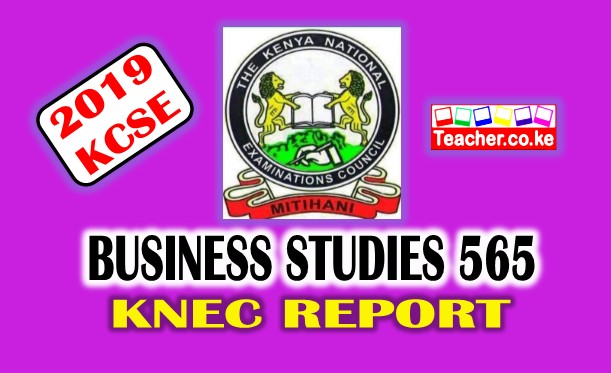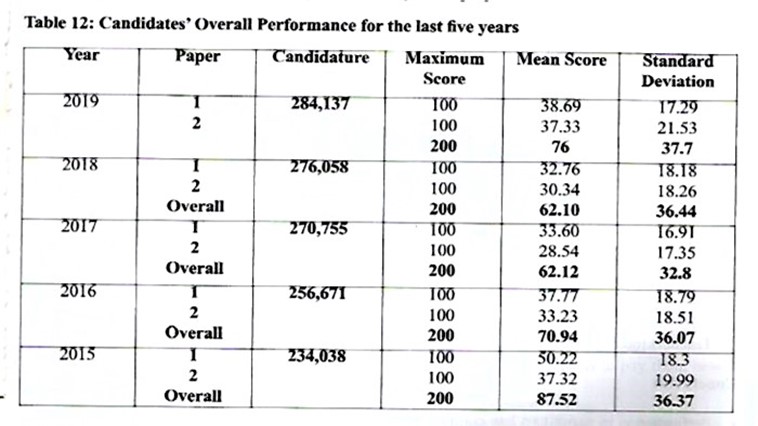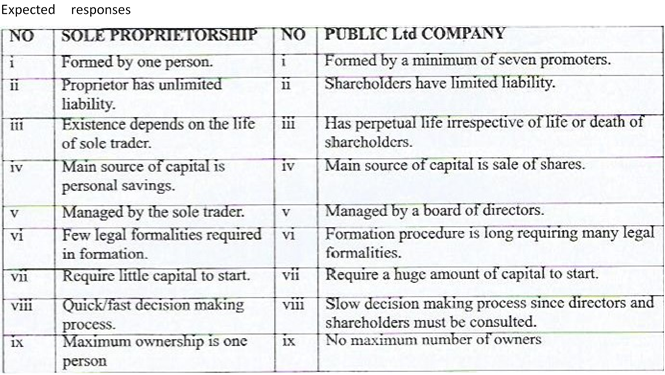
2019 KCSE BUSINESS STUDIES (565) KNEC REPORT
This is the detailed official 2019 KCSE Business Studies (565) examinations report from the Kenya National Examinations Council (KNEC).
Business Studies is an integrated subject comprising five thematic fields of study namely; Commerce, Accounting, Economics, Office Practice, and Entrepreneurship. The aim of the subject is 10 expose the candidates to broad areas of study thus enabling them to specialize at the post-secondary level. For those who may not further their education, the objective is to enable them to be self-reliant and partake of national development through self-employment and entrepreneurship.
Business Studies was tested in two papers. Paper I (565/1), had 25 short answer structured items and was marked out of 100 marks. Paper 2 (565/2), had six extended answer questions out of which the candidates were expected to attempt five questions. The paper was also marked out of 100 marks.
REPORT ON CANDIDATES’ GENERAL PERFORMANCE IN THE 2019 KCSE BUSINESS STUDIES EXAMS
The table below shows candidates’ overall performance in Business Studies (565), in the year 2019. The other years, 201 S to 2018 are also given for comparison purposes.
Table 12: Candidates’ Overall Performance for the last five years

Going by the performance statistics presented in the table above, the following observations can be
- The subject realized an increased enrolment of 8,079 candidates. The candidature in 2019 was 284,137 up from 276,058 in 2018. This was an increase of 2.900.
- The subject registered a marked improvement in performance. The performance improved by
 The subject mean score for the year 2019 was 76, an improvement of 13.9 as compared to the year 2018 when the mean was 62.10.
The subject mean score for the year 2019 was 76, an improvement of 13.9 as compared to the year 2018 when the mean was 62.10. - Candidate performance was almost at par in the two papers. The performance was however slightly better in paper one (565/1 ), when compared to Paper 2 (565/2) as per the respective means Of 38.69 and 37.33_ This implies that many candidates found it slightly easier to tackle the short answer questions in Paper I (565/1) when compared to the extended answer questions in Paper two (565/2).
This report discusses some of the questions that candidates found challenging in the two papers offered for the Business Studies examination.
Business Studies Paper 1 (565/1) 2019 KCSE KNEC Report
Question 2
Outline four factors that make office managers to communicate in writing to their staff. (4 marks)
This question required candidates to outline the factors that favour the use of written communication by managers in organizations.
Weaknesses
Many candidates failed to interpret the question correctly and gave the factors that bar effective communication.
Expected responses
- Confidentiality The confidentiality of the message is enhanced by written means
- Accuracy – the message is delivered in its original form without distortion.
- Future reference. The message may form a basis for decision making in the future.
- Reliability of the means. This is a trusted means of communicating in institutions.
- Economy. It is cost-effective since it is affordable.
- Access1Ylity. It is easily accessible to all staff members.
- Acceptability. It is the acceptable means of official communication in institutions

Advice to Teachers
Teachers should expose learners to the merits and demerits of each form of communication and help learners discuss the factors that favour the use of each form.
Question 5
(a) Outline Tour roles played by the Nairobi Securities Exchange in the Kenyan Economy. (4 marks)
This question required candidates to outline the roles played by the Nairobi Securities exchange in the Kenyan economy.
Weaknesses
Candidates performed poorly in this question since many of them misunderstood the term securities to imply the use of watchmen and the police-
Expected responses
- A measure of the country’s economic performance as reflected in the prices of shares.
- Sets the price; the value of securities based on forces of demand and supply.
- Ensures safety of transactions since the financial health of listed companies is usually verified.
- Promotes economic growth through disinvestment and reinvestment
- Promotes local ownership of companies through the sale and purchase of shares.
- Provides ready marked for sale and purchase of shares hence improving liquidity.
- Promotes saving and investment among the population.
Advice to Teachers
Teachers should vary the use of terms while covering the topic. The learners should be exposed to different terms like stock, securities, and the terms used in the stock market in general.
Question 6
Name the basic concept in population described in the statements given below. (4marks)
- Population size that is adequate for the full utilization of available resources in a country. The average number of births per thousand women in a year.
- a country is experiencing higher death rates than birth rates.
- Where a bigger proportion of the population is comprised of people who are above 55 years old.
This question required candidates to identify the basic concepts in the topic of population and employment
Weaknesses
The candidates did not have mastery of the terms as used in population and employment. They, therefore, made wrong deductions from the statements that were given.
Expected responses
- Optimum population.
- Fertility rate/birth rate (f) Declining population (g) Ageing population.
Advice to Teachers
Teachers should teach this topic thoroughly exposing learners to the terms used in population and employment- Learners must be given the opportunity to discuss these terms to make them more
Question 10
By use of the bookkeeping equation, determine the missing values in the table below: (4 marks)
This question required candidates to apply their knowledge of the bookkeeping equation in calculating the missing values in the table.
Weaknesses
Many candidates committed arithmetic errors ending up with the wrong answers. Many others did not establish the relationship between the bookkeeping equation and the items in the balance sheet. They failed since the normal approach is where assets and liabilities are not separated into their components.
Advice to Teachers
Teachers should give learners many questions for practice- This should include where assets are separated into fixed assets and current assets, and liabilities also separated into long term and short term liabilities.
Expected responses
- 458,900
- 594,350
- 892,735
- 1,510,110
Business Studies Paper 2 (565/2) 2019 KCSE KNEC Report
Question 1
Explain five differences between a sole proprietorship and a public limited company. (10 marks).
This question required candidates to distinguish between a sole proprietorship and a public limited company.
Weaknesses
Many of the candidates confused public limited companies with public corporations hence gave  wrong differences
wrong differences
Expected Responses

Advice to Teachers
Teachers should emphasize on the features of each form of the business unit. Learners should discuss the characteristics of the business units, distinguishing each from the other especially public limited companies from public corporations.
Question 3 (b)
Explain five measures that may be taken to increase the volume of exports. ( 10 marks) This question required candidates to explain the measures that may be taken to increase a country’s
Weaknesses
The majority of the candidates displayed a lack of knowledge in this area of international trade and simply wrote responses that were irrelevant.
Expected responses
- Through an export compensation scheme where exporters are allowed to claim a certain percentage of the value of their exports.
- Diversifying foreign markets to expand the market for exports. This increases the selling
 opportunities for local products in other countries.
opportunities for local products in other countries. - Lobbying for removal of trade restrictions imposed by trading partners on the country’s exports. This makes it easy to sell local goods in foreign markets.
- Devaluation of a country’s currency which makes its exports cheaper hence more attractive to foreign buyers.
- Encourage foreign investments in the country e.g. EPZ’s. This ensures the production of quality goods that meet the specifications of foreign countries.
- Reduction of bureaucracy in the acquisition of export licenses. This makes it easy and attractive to engage in foreign trade.
- Subsidizing export-oriented businesses. This increases the profit margin for exporters making the trade more attractive.
- Use of commercial attaches to promote the country’s products abroad. Aggressive promotion of the country’s exports leads to increased sales in those countries.
- Customs draw back where part of import duty paid on imported raw material is refunded if used to produce goods for export.
- Lower tax/duty on exports to enable them be sold at lower prices that attract foreign buyers.
Advice to Teachers
Extensive tuition should be offered to learners in the topic of international trade adequately covering all the subtopics.
Question 6(b)
Outline five assumptions associated with the circular flow of income in a two-sector economy. (10 marks)
This question required the candidates to bring out the basic assumptions that define the existence of the circular flow of income in a two-sector economy.
Weaknesses
A majority of the candidates displayed a lack of knowledge in this question. Others simply explained the circular flow of income in a two-sector economy.
Expected responses
- There are only two sectors ‘players in the economy, that is, households and firms.
- Households spend all their income on goods and services without making any savings.
- Firms spend all their revenues on factors of production without reserving any profits for expansion.
- There is no government interference through taxation, licensing, etc.

- The economy is closed to international trade.
- All output produced by firms is purchased by households.
- There is no financial sector to inject income through investment/lending or withdraw the incomes through savings.
Advice to Teachers
Teachers should teach and explain the assumptions of the circular flow of income in a two-sector economy as they introduce this concept.